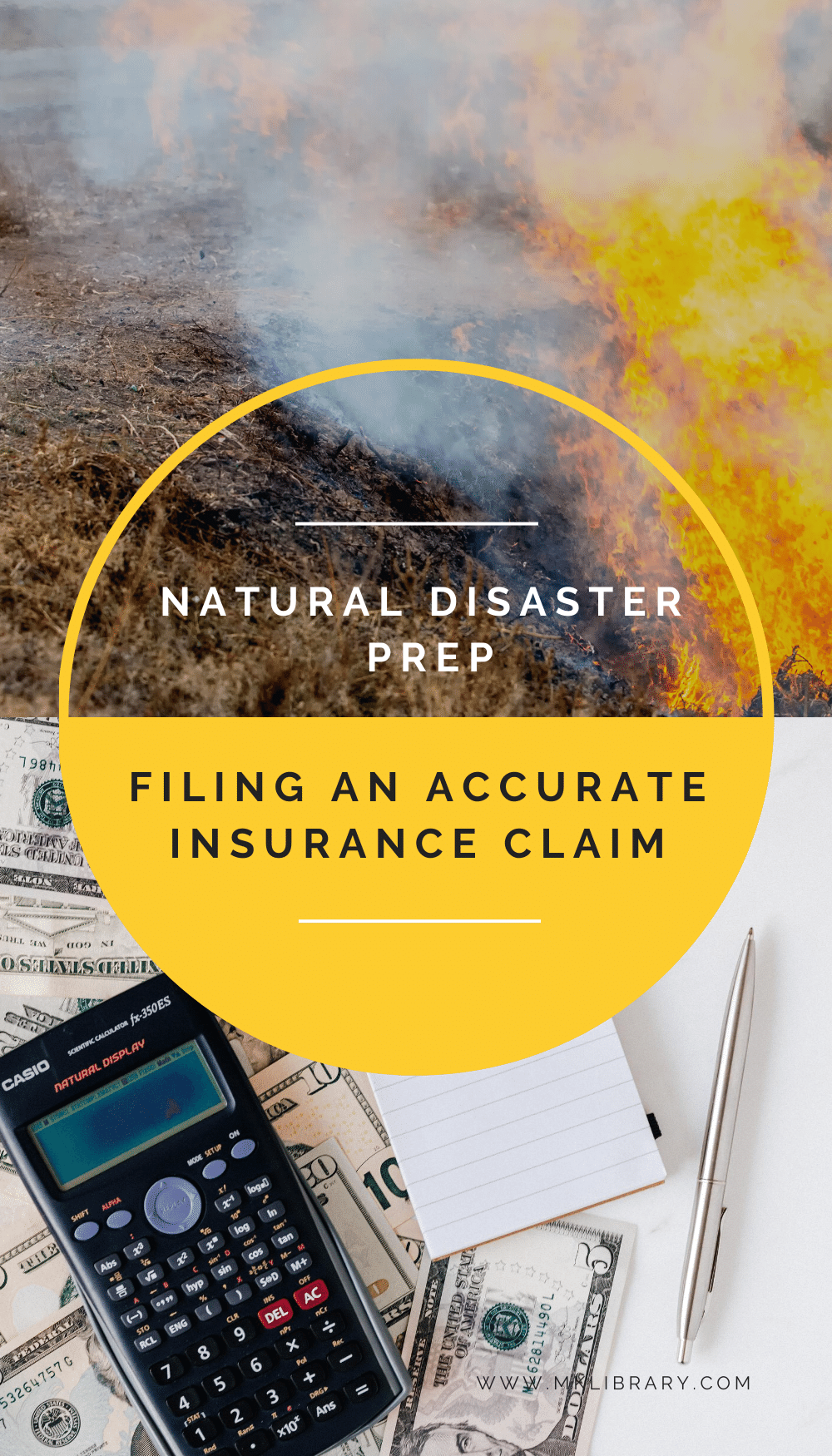In the event of a total loss, disaster, or catastrophic event, filing an insurance claim for your home often leads to an incredible amount of added stress. Not knowing the specifics of how insurance companies process your claim not only makes the filing process significantly harder, it can also result in underestimating the true value of your home and material losses.
As a California resident, I’ve witnessed friends, family and strangers alike lose their homes to devastating wildfires. If this information can help just one person in navigating this process, it will have been well worth the effort.
While much of this advice is written specifically for homeowner’s insurance policies, much of the information can carry over to other policy types and circumstances. This is a compilation of anecdotal evidence, research from my own insurance company and a few other carriers, and some interviews with people in the insurance industry.
Table of Contents
The Home Insurance Claims Process
Just about every insurance company follows the same process in processing claims:
- Report your claim, either online or over the phone to your agent.
- The insurance company assigns your case to a claims adjuster.
- The adjuster contacts you to get details about your loss and outlines the insurance company’s process from here.
- The adjuster will give advice and recommendations on preventing further damage or mitigating additional loss.
- An investigation of your claim will require inspecting the damage, collecting facts, estimating your losses, consulting witnesses, and reviewing your documentation.
- The more complicated and detailed your claim is, the longer a resolution will take.
- The adjuster may offer you an on-the-spot settlement. In most cases, you can accept and deposit the check immediately. You can reopen the claim with more information for an additional settlement. Check with your adjuster first, based on the insurance company’s policies and your state law, and receive an answer in writing.
Your Claims Adjuster
One important thing to remember in discussing claims is that your claims adjuster has one primary job: Saving the insurance company money.
If you go into this process with an understanding of their role and the process, you will have a lot more success. Claim adjusters have a difficult job, and are largely beholden to strict guidelines set in place by the insurance company. With that said, those who are good at their job will often provide hints and help you through the difficult process. As with anything, its best to be open in your communication, truthful, and ask for specific help when needed.
Arguing your case with the adjuster does little good, so find ways to get them to empathize with your situation. Homeowners with private flood insurance tend to display everything the water has destroyed in the aftermath of a disaster. This is generally a good idea to do, as it helps paint a picture for the adjuster.
How a Claims Adjuster Determines Value
I spoke with an anonymous claims adjuster who explained how they determine the value of all items in your claim. Using this knowledge, you can better increase reimbursement for lost items in the event of a disaster. Here’s a summary of what they said:
“Our goal was to use the information you provided, and give the lowest value we can possibly justify for your item. For instance, if all you say was “toaster,” we would come up with a generic $4.88 toaster from Walmart, meant to toast one side of one piece of bread at a time. And we would do that for every thing you have ever owned. We have private master lists of the most commonly used descriptions and their cheapest viable replacements. We also have wholesale pricing on almost everything out there, which allows us to quote even cheaper replacements for your claim.”
This is how the pricing and replacement system works according to a claims adjuster:
Broad/general descriptions:
If you listed, “toaster – $25,” we would have to find a toaster priced within 20% of your price. We would find a toaster which costs exactly $20.01. If you listed, “toaster- $200,” we’d request more information and proof, because that’s a extremely high price for a toaster. And if you listed, “toaster, from Walmart,” you’re simply getting that $4.88 one.
More Specific descriptions:
If you listed, “toaster, from Macy’s,” you’d be more likely to get reimbursed for a $25-35 one. Also, if you put “toaster”, and all your other kitchen appliances were higher end appliance brands such as Jenn Air, Kitchenaid, Wolf, Subzero, etc., you have a good chance of getting reimbursed for an appropriate match of the same brand.
If you listed “High-end Toaster, Stainless Steel, Blue glowing power button” without a price you might get $35-50 replacement instead. We had to match all features that were listed.
Exact make and model descriptions:
Finally, if you listed the exact model, such as the “Proctor Silex 42888 2-Slice Toaster from Walmart,” you would get the exact replacement worth $9.
As always, be as truthful as you possibly can. If you can’t remember an exact model, try to list specific features the product has. Lying about a possession is not worth the risk, as the insurance adjuster will likely find out, and a single lie will invalidate the entire claim.
Again from the claims adjuster: “I remember one specific customer. He had some old, junky projector from the mid-90’s that could stream an equally junky consumer camcorder. It seemed to be worth maybe $5 to a scrap yard. It had some odd resolution it could record at, though, and the guy strongly insisted that we replace with “Like Kind And Quality” (trigger words for an adjuster). He ended up getting a $65k replacement, because the only camera on the market happened to be a high-end professional movie studio quality video camera. He received $65 thousand dollars because he knew how our process worked, and researched the details.”
Remember, every detail can help you reclaim the money you lost. For example, if I was writing up the value of my bathroom shower, I would include:
- Designer Shower Curtain – $35
- Matching Shower Curtain Liner for Designer Shower Curtain – $15
- Shower Curtain Rings x20 – $15
- Stainless Steel Soap Dispenser for Shower – $35
- Natural Sponge Loofah from Whole Foods – $15
- Natural Sponge Loofah (for back) from Whole Foods – $19
- Holder for Loofahs – $20
- 4 bars of soap from Lush – $12 each
- Bath bomb from Lush – $12
- High end shampoo from salon – $40
- High end conditioner from salon – $40
- Refining pore mask from salon – $55
I could probably keep thinking, and bring it up to about $400 for the contents of my shower. Nothing here is “unreasonable,” clearly out of place, or seems obviously fake. The prices are a little on the high-end, but many people have expensive personal care products and it won’t actually be questioned. Most people writing claims for a total loss might ignore their shower products, with the mentality that “It’s just some used soap and sponges.” Those people may be losing out on as much as $400.
The reality is that a claims adjuster is not likely going to nitpick the cost of a Lush bath bomb when there are multiple 20,000-item files on their desk needing attention. Additionally, the adjuster has other investigative work to do on top of that.
Some things require documentation and dates.
If you list a “tv – $2,000″ you’re getting a 32” LCD, unless you can provide it was from the last year or two with receipts and proof of purchase. Paper trails will help, including credit card statements, bank statements, product registrations, and emailed receipts. Photo or video evidence will also help.
If you’re missing paper trails for things that were legitimately expensive, go through every photo you can find that was taken in your house. Search through Facebook memories for pictures from friends at your house, or find that photo of your cat hiding under a coffee table you think you purchased from Restoration Hardware. Come up with any evidence you possibly can for those items that could be deemed expensive and questioned.
A note from the claims adjuster: Don’t take advantage of the system. “Fire-truck chasing” loss adjusters have very questionable ethics and will write up your claim “creatively” for the insurance company to process.
“Sometimes people would come back to us with updated claims. They tried listing all of their items on their own, and listed things like “toaster,” “microwave,” or “tv” and weren’t happy with what they received. Then, they hired a fire-truck chaser, and re-submitted their claim with more information. I have seen claims go from under $7k calculated, to over $100k calculated when people suddenly “remember” their entire wardrobe came from Nordstrom.”
Plan for the Worst, Hope For the Best
While this section may be too late if you are already faced with catastrophe, planning for the day you may have to make an insurance claim will go a long way in reducing your stress level. It may require some extensive preparation, but in the midst of California’s nearly 400 active wildfires, the chances of you being affected by one are high.
Keep a Copy of Your Insurance Policy
Make sure you keep both a paper and electronic copy of your insurance policy available. If you have a paper copy, it’s a good idea to store it somewhere safe outside your home. If disaster strikes, making sure to grab your insurance policy will be one less thing you have to remember. Register on your insurance company’s website and make sure your policy is connected to your account, and download a PDF of your policy. Save it to your computer and to the cloud.
Document Your Belongings
Documenting everything you own is incredibly tedious, so start with the big things and work your way down from there. Using your phone or video camera, go into each room and spend at least 10 minutes recording all your belongings. Do this in a room by room basis, saving the videos as you go.
Go back through and take photographs of the entire room and closeups of important or highly valuable items. If you feel pretty comfortable with videoing and are ready for more detail, you can go back and record while you verbally describe items in detail. Beware, these videos will end up long if you find yourself taking tangents like me.
Upload these photos and videos to your cloud storage in a private album for your house.
Another method of documentation is to use a receipt scanning app and organizer. Most will have a monthly subscription. The best thing for you to do is to try a few out and see which one is easy for YOU to use. Practice searching for an older receipt to make sure you can actually use the app for its intention.
I’ve implemented a combination of all the above methods over the years. In addition, I’ve created a spreadsheet with a sheet for each room. It contains a list of major furniture items, relevant info about the room such as paint color, and which circuit on the breaker the plugs go.
The list of major items has columns for the purchase date, price, and any other details I might need, such as serial number or model number. The purchase date allows me to cross-reference either photos from the same date range, receipts in my inbox, or my narrowing down the search on my receipt app.
Practice Your Strategy
Much like a fire drill, practice your methods and make sure everything works will save you time in the long run.
Try and download your saved documents and photos. Make sure you know how to login to your insurance company’s website or your cloud backups if you have lost your own computer. Give yourself a dry run and figure out what you can improve on.
Preparing for a natural disaster by documenting will undoubtedly make your life easier in the event that you ever have to file an insurance claim. Start small, research your plans of action and most importantly, stay safe!
Pin this!

- About the Author
- Latest Posts
I strive to paint vivid landscapes with my words, bringing the magic of far-off lands and enchanting aromas to life for my readers. Combine passion for exploration and the art of gastronomy in an unending ode to the senses. When I’m not traversing the globe, I find solace in the earth beneath my fingertips, tending to my garden and working on projects around my verdant oasis. MK Library serves as a beacon, guiding fellow travelers and homebodies alike to embrace sustainability, nurturing both our planet and our souls with purpose. Full Bio.





